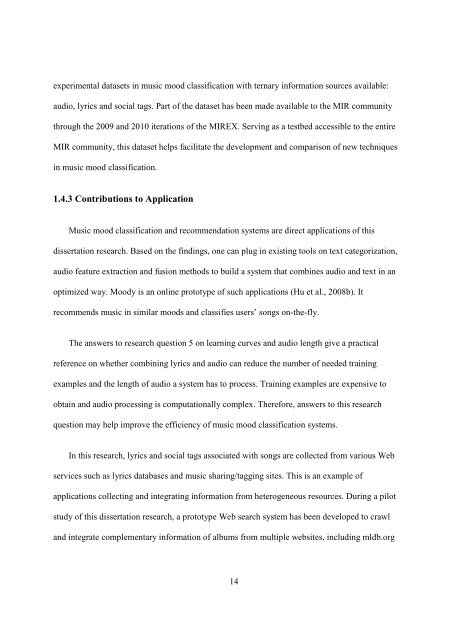improving music mood classification using lyrics, audio and social tags
improving music mood classification using lyrics, audio and social tags
improving music mood classification using lyrics, audio and social tags
You also want an ePaper? Increase the reach of your titles
YUMPU automatically turns print PDFs into web optimized ePapers that Google loves.
experimental datasets in <strong>music</strong> <strong>mood</strong> <strong>classification</strong> with ternary information sources available:<br />
<strong>audio</strong>, <strong>lyrics</strong> <strong>and</strong> <strong>social</strong> <strong>tags</strong>. Part of the dataset has been made available to the MIR community<br />
through the 2009 <strong>and</strong> 2010 iterations of the MIREX. Serving as a testbed accessible to the entire<br />
MIR community, this dataset helps facilitate the development <strong>and</strong> comparison of new techniques<br />
in <strong>music</strong> <strong>mood</strong> <strong>classification</strong>.<br />
1.4.3 Contributions to Application<br />
Music <strong>mood</strong> <strong>classification</strong> <strong>and</strong> recommendation systems are direct applications of this<br />
dissertation research. Based on the findings, one can plug in existing tools on text categorization,<br />
<strong>audio</strong> feature extraction <strong>and</strong> fusion methods to build a system that combines <strong>audio</strong> <strong>and</strong> text in an<br />
optimized way. Moody is an online prototype of such applications (Hu et al., 2008b). It<br />
recommends <strong>music</strong> in similar <strong>mood</strong>s <strong>and</strong> classifies users’ songs on-the-fly.<br />
The answers to research question 5 on learning curves <strong>and</strong> <strong>audio</strong> length give a practical<br />
reference on whether combining <strong>lyrics</strong> <strong>and</strong> <strong>audio</strong> can reduce the number of needed training<br />
examples <strong>and</strong> the length of <strong>audio</strong> a system has to process. Training examples are expensive to<br />
obtain <strong>and</strong> <strong>audio</strong> processing is computationally complex. Therefore, answers to this research<br />
question may help improve the efficiency of <strong>music</strong> <strong>mood</strong> <strong>classification</strong> systems.<br />
In this research, <strong>lyrics</strong> <strong>and</strong> <strong>social</strong> <strong>tags</strong> associated with songs are collected from various Web<br />
services such as <strong>lyrics</strong> databases <strong>and</strong> <strong>music</strong> sharing/tagging sites. This is an example of<br />
applications collecting <strong>and</strong> integrating information from heterogeneous resources. During a pilot<br />
study of this dissertation research, a prototype Web search system has been developed to crawl<br />
<strong>and</strong> integrate complementary information of albums from multiple websites, including mldb.org<br />
14
















